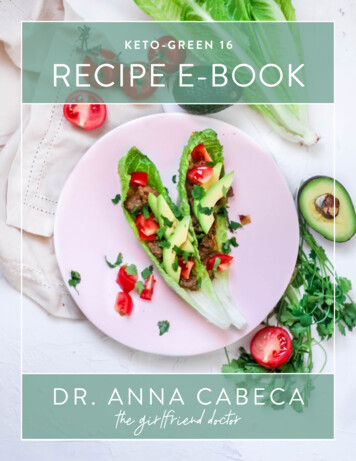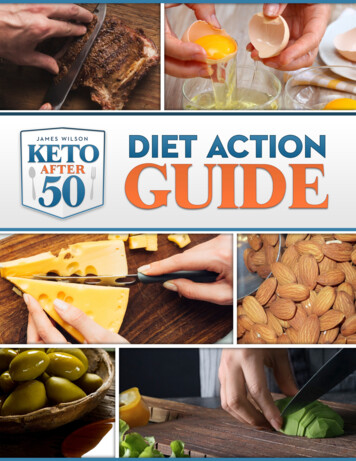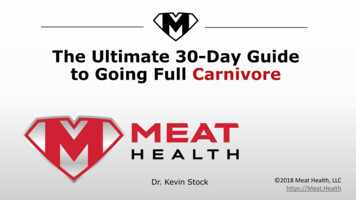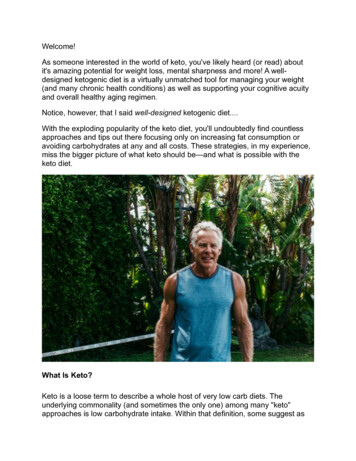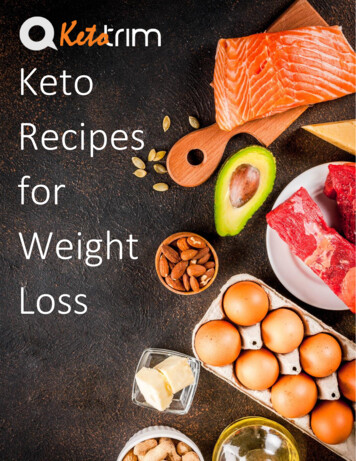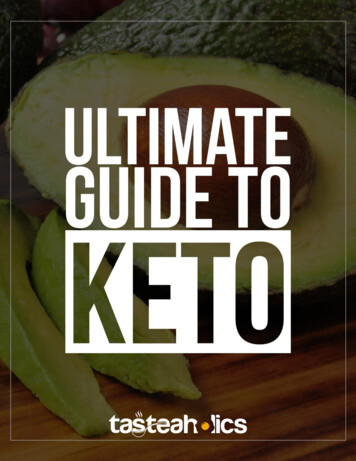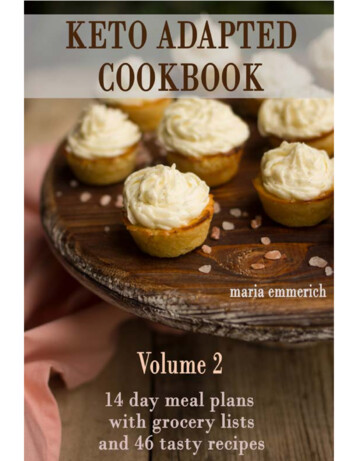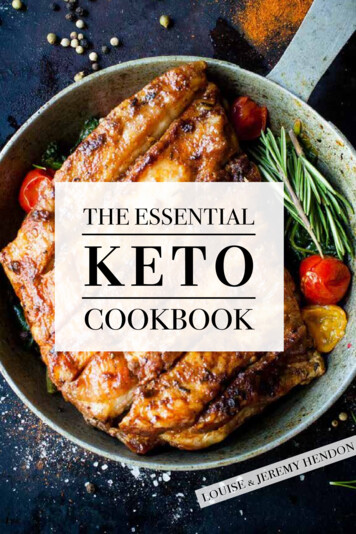
Transcription
THE ESSENTIALKETOCOOKBOOKISLOUE&EMJERYDHENON
Page 2OHH - ITRY ALRECopyright 2019 JL Publishing LLCFourth EditionAll rights reserved. This work may not be reproduced or distributed - in whole or in part- by any means or in any form, electronic or otherwise, or stored in a database or otherretrieval system, without the express, written permission of JL Publishing LLC.Disclaimer: This book is intended for entertainment and informational purposes only.Please consult your doctor or other medical professional before undertaking any new diet orexercise program. All nutritional data provided are estimates and should not be relied uponfor any medical purposes. The publisher and author of this cookbook are in no way liableor responsible for any adverse effects that may arise (directly or indirectly) as a result of theinformation provided in this book.Photo copyrights: All recipe photo copyrights owned by Louise Hendon - other designimages are from fotolia.com.the EssentialKETOCOOKBOOK
WANT TOSEEHTFOLLECIPES!TABLE OFCONTENTSWhat is Keto?Is A Ketogenic Diet Safe?Will A Ketogenic Diet Help Me Lose Weight?Mistakes To Avoid4 Tips For Meal PlanningCHAPTER 1: BreakfastCHAPTER 2: AppetizersCHAPTER 3A: Chicken EntreesCHAPTER 3B: Beef EntreesCHAPTER 3C: Pork EntreesCHAPTER 3D: Fish and Seafood EntreesCHAPTER 3E: Other EntreesCHAPTER 4: Side DishesCHAPTER 5: Desserts, Breads & SnacksCHAPTER 6: Condiments, Seasoning & SaucesCHAPTER 7: Drinks and Brothspage 4page 5page 6page 7page 11page 12page 25page 39page 56page 79page 86page 94page 98page 108page 124page 132
Page 4A BRIEF HISTORY OFTHE KETOGENIC DIETWHAT IS AKETOGENIC DIET?A keto or ketogenic diet is a diet plan thathelps your body achieve nutritional ketosis.That means your body is relying primarilyon fat and ketones (rather than sugar) for itsenergy. Ketones are produced when your bodybreaks down fat.The cells in your body can create energyfrom one of four sources. They can use fat,carbohydrate, protein, or ketones.When you go on a ketogenic diet, you forcethe cells in your body to primarily use fat andketones for fuel. And there are several benefitsof doing this, which I’ll explain in a bit.Most people can achieve nutritional ketosisby eating a lot of fat, moderate amounts ofprotein, and few carbohydrates.But there are also many mistakes I seepeople make. So please make sure to read thesection on page 7 titled “ MISTAKES TOAVOID ON A KETOGENIC DIET.”First.The ketogenic diet has gotten popular recentlyas an effective fat loss diet. But it was originallydesigned in the 1920s by Dr. Russell Wilder at theMayo Clinic.Dr. Wilder used ketogenic diets as an effectivetreatment for epilepsy in children. However, afteranti-seizure medications became widely available,the ketogenic diet fell out of favor.From 1940 until almost 1980, there was littleinterest in ketogenic diets.Then, the popularity of low-carb (or Atkins)diets started to rekindle interest. And the riseof Paleo diets has prompted a full resurgence ofinterest in the ketogenic diet.This time, though, the primary focus is weightloss and health.In 2013, the ketogenic diet was the 5th mostsearched-for diet on Google. Since that time, itspopularity has only increased.In fact, a clinical trial began in 2015 to testthe impact of a keto diet on type 2 diabetesand pre-diabetes. The results aren’t out yet, ofcourse. Still, more research is now underway tounderstand the benefits of keto diets.the EssentialKETOCOOKBOOKs!Ditch the sugar and eat real food
Page 5IS A KETOGENIC DIET SAFE?First, a quick disclaimer. I am not a doctor, medical professional, or nutritionist. Anysuggestions provided in this book are not a substitute for medical or nutritional advice. Youshould definitely consult your physician before beginning any exercise or nutrition program.With all that in mind, the answer is generally yes. A ketogenic diet is safe for healthyadults. But there is a lot of misinformation about keto diets. Consequently, many people willtell you that ketogenic diets are dangerous.Here are a few quick facts you should know about the ketogenic diet and its safety:1. Ketosis is NOT the Sameas Ketoacidosis.Many people (includingmedical professionals) get confusedabout this. Ketosis is when yourbody uses ketones as its primaryenergy source (instead of glucose).Ketoacidosis is somethingaltogether different. First of all,it’s a serious medical condition. Itusually occurs in a few differentsituations: Type 1 diabetes. Alcoholic binges. End-stage Type 2 diabetes. Extended periods ofstarvation (over the course ofmonths). Prolonged severe exercise. A few cases of Ecstasy usehave caused ketoacidosis.In ketoacidosis, the bodyproduces an excessive amount ofketones. That causes the blood tobecome acidic, which can be quitedangerous.In a healthy adult, the bodywill regulate the amount ofketones produced so that thisdoesn’t happen. For instance, thebody will release insulin to stopthe burning of fats.Eating a ketogenic diet or evenfasting for a few days will NOTcause an overload of ketones.3. Pay Attention ToYour Gut Health2. Carbohydrates areNOT EssentialThis is another commonmisconception.Protein, some fats, andmany vitamins and minerals areessential for the human body.Carbohydrates, however, are notessential.Cells that lack amitochondrion (such as somevery small neurons and redblood cells) always need a smallamount of glucose. But even inketosis, your body can easily fillthose needs by turning proteininto glucose.This is how you can live for40-60 days without eating. Yourbody converts fat stores intoketones, which your body thenuses for energy.Over the years, this is oneof the biggest mistakes I’ve seenpeople make.Meat and seafood are great,but your gut won’t thrive onthose foods alone. You mustmake sure to eat plenty ofvegetables that are high in fiberto support your gut.The bacteria and othermicroorganisms in your gutneed prebiotic fiber and resistantstarch to do their job.So besides fibrous veggies,also consume probiotics,prebiotics (check out CoBionicFoundation for this!), andfermented foods on a regularbasis.I highly recommend a green smoothie to startthe day (check out the recipeon page 13).the EssentialKETOCOOKBOOK
Page 6KETO VS LOW CARB VS PALEOIn most ways, a ketogenic diet is very similarto a low carb diet. In particular, you must restrictcarbohydrates in both diets.The difference is that a ketogenic diet is all aboutmaking sure that your body is in ketosis. While eatinglow-carb is a big part of that, it’s not the only thing youshould think about.Some people can eat a high amount of daily carbsand still be in nutritional ketosis. Other people need toeat much fewer carbs and also make other adjustmentsto achieve the same state. Men usually seem to have iteasier than women in this respect.I like to think of a ketogenic diet as a more preciseversion of a low-carb diet. You’re paying closerattention to what’s going on in your body. Ratherthan focusing only on how many carbs you eat, you’reensuring that your body is burning fat for energy.I'm also a huge proponent of the Paleo diet, and theway I suggest everyone does Keto is with a Paleo Ketodiet. That means eating real foods that nourish yourbody instead of just counting macros.But please don’t get stuck on the labels. In the end,you can be on a low-carb, ketogenic, or even Paleo diet,and still be eating exactly the same foods!Each diet places a slight emphasis on a differentaspect of what you eat, but the results can be identical.Most people would consider every recipe in thiscookbook to be Keto, Low Carb, and Paleo (as well asdairy-free, sugar-free, grain-free, and gluten-free!).My best suggestion is to forget about theclassifications. Instead, ask yourself these questionsabout the food you eat:What is this food doing for or to my body?Does this food provide me with nutrients (e.g., vitamins,minerals, essential amino acids, etc.)?Does this food contain toxins (gluten, processed sugar, etc.)that could prevent my body from functioning well?Does this food hinder my body from staying in ketosis?T?SE WEIGSoHI canHELP ME LO’tGENIC DIETess than others.succemorehavpleWILL A KEis TOpeoebt, somnot magic. Without a douA ketogenic dietI truly believe that aresults.guarantee any particularht with ketogenic diets. Andy people lose a lot of weigmanseenehavht.I,weigeverHowst ways to losemost effective and healthie.ketogenic diet is one of theketogenic diets work so wellwhyonsreasbigfewaThere are1. Controlling Hunger2. Metabolic FlexibilityThis is the single biggest reason that ketogenic dietsare great. And it’s also the biggest reason that mostother diets fail.Ketogenic diets help your body’s regulation ofhormones and neurotransmitters. One of the results isthat you get much less hungry.That means reduced cravings for junk food, lesscheating, and more weight loss.If you’ve ever dieted before, then you know thatsticking to it is the hardest part. Sticking to a ketogenicdiet is much easier, because you don’t face the samehunger.If you’ve been eating a high-carb diet, then yourbody is excellent at burning carbohydrates for energy.That makes sense when you’re eating a lot of carbs.But it also means that your body is often not good atburning fat.Ideally, your body should be able to switch back andforth between burning carbs and fat. When your bodycan’t do this, it’s called “poor metabolic flexibility.”In that case, you don’t burn much fat, you getcravings for sugar and carbs, and you have a hard timelosing weight. That’s one of the reasons that you mightget hungrier on a high-carb diet. If your body can’tburn fat well, then you’ll be hungry whenever yourblood sugar is low.A ketogenic diet can help you regain metabolicflexibility. By putting your body into a state of ketosis,you force your body to get better at burning fat.And many people find that they end up burning alot of their bodies’ fat stores, which is exactly what youwant for weight loss.the EssentialKETOCOOKBOOK
Page 73. Hyper-Palatability4. Inflammation and Toxins3. You might have never heard of hyper-palatable foods.Yet nothing has contributed to obesity more in moderntimes.A food is hyper-palatable when it has a “magic”combination of fat, sugar, and salt. The result is thatfoods become addictive. You can’t stop eating them,even if you’re full.And food manufacturers make use of thatcombination to create irresistible processed foods. Frompotato chips to cookies to donuts, humans have created athousand addictive foods.But none of these foods occur in nature. Fruitsusually have sugar, and meats usually have fat, but youdon’t find foods with both.By removing refined carbohydrates, a ketogenic dietalso removes hyper-palatable foods. And that meansyou won’t feel an unstoppable need to keep eating andeating.The result is that most people feel less hungry andhave fewer cravings.This means you’re effortlessly restricting yourcalorie intake, leading to more weight loss.Finally, a ketogenic diet also helps you to removetoxins and reduce inflammation.You may not even see or be aware of chronicinflammation. But inflammation in your body is a bigobstacle to weight loss.And the main causes of inflammation are many ofthe foods you eat. The biggest culprits are wheat andother grains, milk, and processed sugar.Coincidentally, these are all foods that you mustavoid on a ketogenic diet.MISTAKES TO AVOID ON A KETOGENIC DIETIn this section, I want to cover some of the mistakes that I often see people make on a ketogenic diet. If you canavoid these mistakes, then you’ll be much more likely to lose weight and feel better.Mistake #1: Bad MindsetMany people treat the ketogenic diet assomething they’ll “try for a week or two.”They want to dip their toe in the water to see if thediet “works.” But they definitely don’t want to commit.There are two problems with this approach. Firstof all, if you’re not committed, then you’re going to giveup at the first sign of trouble. If you get tempted, or ifyou don’t lose weight for a few days, then you’ll give itall up. And I can guarantee that not everything will goperfectly for you. It never does.The second problem is that no diet works unless youapproach it as a lifestyle.If you want, you can lose some weight and thengo back to eating bread, pasta, and sugar. But if yougo back to eating those foods, you’ll also go backto gaining weight. That is what we call the yo-yodieting trap.Mistake #2: Eating Too MuchMany of us have developed bad eating habits. We'lleat until everything is gone on our plates, we'll eat whenit's mealtime rather than when we're hungry. And we'llsnack all day instead of eating real meals.All of this unfortunately leads to a lot of overeating.Mistake #3: Not TestingOur bodies are all a little bit different. Two peopleeating the same ketogenic diet can sometimes getdifferent results.One person could be in ketosis and losing weight,and another person could be struggling.That’s why testing is so important. You need tomake sure that you’re actually in ketosis. And if youaren’t, then you can make adjustments to your diet andlife.When you’re in ketosis, your body will produceketone bodies. There are 3 types of ketone bodies:Acetoacetate (AcAc), Beta-hydroxybutyrate (BHB), andAcetone.In your blood, you can measure all 3 ketone bodies.In your urine, AcAc and Acetone can be measured.And in your breath, just Acetone.Your blood ketone levels are the best indicator ofketosis. Unfortunately, measuring blood ketone levels isalso the most expensive method.That’s why many people still measure their urineand breath ketone levels instead.For weight loss, you don't need to chase high ketonelevels - measuring and tracking ketones is just anotherway to get more data about what's happening in yourbody so don't get stuck on ketone levels!the EssentialKETOCOOKBOOK
Page 8Mistake #4: Not Eating Enough Nutrient-DenseFoodsOn a ketogenic diet, you’ll pay a lot of attention tothe macronutrients you eat and you can use our KetoCalculator to figure out the right proportion of fats,carbs, and protein for you: https://ketosummit.com/ketocalculatorBut don’t forget that you also need to be gettingenough vitamins and minerals.You might be aware of some terrible things thathappen if you’re severely deficient in a micronutrient.For example. You can get scurvy if you don’t get enoughvitamin C. You can get goiter if you’re deficient in iodine. Or you could go blind if you don’t get enoughvitamin A.sider is a DEXA scan.Another great test to conr fat levels as wellThis test will measure youls. If you do itlevesclemuandas your bonebe able to later’llyoubefore you start your diet,t is working.dieryoulwelhowlytrack preciseBesides those acute problems, chronic deficienciescan also be a huge problem. Often, nutrientdeficiencies are not so severe that you exhibit aparticular disease. That doesn’t mean, though, thatthey’re not making you less healthy.Over time, if you’re low in vitamins and minerals,your body just won’t function well. That can lead toillnesses, fatigue, and more. Even minor vitamin andmineral deficiencies might be making it harder for youto lose weight.An easy way to boost your micronutrient intake isto eat more nutrient-dense foods. Most of these foods fitwell into a ketogenic diet.For instance, green leafy vegetables, organ meats,and seafood are all ketogenic-friendly. And they’resome of the most nutrient-dense foods you can eat.Supplementation with a good multivitamin orgreens powder is also helpful.If you’re into testing, then try getting a SpectraCellanalysis or an Urine Organic Acid test. Both of thesetests will tell you which vitamins and minerals you’redeficient in. That way, you can focus specifically onthose deficiencies.Mistake #5: Eating Toxic, Inflammatory Foods Even if They’re Low CarbNot everything that is low in carbs is good for you.Period.For example, you can go to most grocery storesthese days and find low-carb processed foods. You canget low-carb bread, low-carb cookies, and low-carbsnacks.You might be able to stay in ketosis while eating thoselow-carb foods, but they’re still bad for your body. Manyof them contain wheat, gluten, and other inflammatoryingredients.And as I mentioned, inflammation always makes itharder for you to lose weight.Here are ingredients that I suggest avoiding, even in lowcarb foods: Wheat, Rye, and Barley. New technologyhas created a way to make these foods low-carbsometimes. But they still always contain gluten, whichwill inevitably cause inflammation in your body. Plus,they’re not very nutrient-dense. Dairy. Yes - even cheese. In the abstract, dairymight be ok. The problem is that you don’t live in anabstract world. Milk will pretty much always keep youout of ketosis. And the vast majority of people havesome level of sensitivity to dairy products like cheese.(This is most likely true even if you aren’t lactoseintolerant.) Plus, you're likely to overeat cheese andcream! Vegetable and Seed Oils. This includes VegetableOil, Canola Oil, Corn Oil, Sunflower Oil, and similarproducts. Your cooking oil also makes a huge differenceto your weight loss. As Dr. Shanahan points out inher book, Deep Nutrition, the production of these oilsproduces trans-fats, which can block your enzymes forburning fat. Any food you have an intolerance to. Startpaying more attention to your body. If you wake up oneday and notice that you’re congested or that your jointsare stiff, ask yourself what you ate. You’re likely sensitiveto one of the foods you ate the day before.Also, be careful with nuts. Many people haveallergies or sensitivities to nuts. But more than that, nutsare easy to overeat. Again, a ketogenic diet is not magic,so eating 3,000 calories of nuts per day is going to makea difference.Mistake #6: Ignoring Sleep, Exercise, and StressWhile eating a good diet is important for weightloss, it’s not all that matters.Many weight-loss studies have stressed theimportance of sleep (7 hours), exercise, and destressing. It’s tough to get everything right all at once.Still, any small efforts you make in these areas will payoff in the end.Mistake #7: Not Being PatientIt can take up to two or three weeks to become ketoadapted. So if you’re going to give the ketogenic diet atry, then actually give it a try and be patient.It’s taken you a lifetime of eating poorly to get towhere you’re at. You can’t expect to fix all that damagein just a few weeks.the EssentialKETOCOOKBOOK
Page 9Mistake #8: Not Eating Enough FiberMainstream nutrition has gotten a lot of thingswrong.The importance of fiber is not one of them. Thepast few years of scientific research has shown just howimportant fiber is for your gut health.In particular, soluble fiber and resistant starchesfrom vegetables can improve your gut bacteria.Fermented foods like sauerkraut are also excellent inthis regard.And if you have trouble eating enough vegetablesthen take a good prebiotic like the CoBionicFoundation.WHAT IF A KETOGENICDIET DOESN’T HELP MELOSE WEIGHT?This is a fear that I hear all the time.“What if I put in all this effort - give up all thesefoods - and it still doesn’t work?”I completely understand this fear. I used to askmyself the same thing.But this is also the reason why I don’t believe in“dieting.” Dieting is a short-term project where youronly goal is to lose weight.I’m not saying that you shouldn’t try to lose weight.I think it’s often a worthwhile goal.But if that’s your only goal, then you’ll bedisappointed if you go even a few days without anyresults. And in the world of weight loss, you willdefinitely have times when you stall a little bit.A more practical way of thinking is to focus ondoing the right things, rather than just on the results.Make it your goal every day to feed your body foodsthat give it energy, vitamins, and minerals.Appreciate every healthy food you eat, knowingthat it will give you lasting health. In that way, you’llnaturally lose weight, keep it off, and gain better healthas a result.That’s why this cookbook isn’t just about replacingthe carbs in your diet with other junk.This is not just another low-carb cookbook.Instead, this cookbook will help you focus on theprinciples behind the ketogenic diet. (And, of course,provide you with delicious ketogenic foods as well.)I want you to lose weight. But I also want you toenjoy nutrient-dense and delicious foods that are low intoxins.That way, there’s no downside to eating recipesfrom this cookbook. Even if you don’t lose weightimmediately, you’re still feeding your body nourishingfoods.At this point you might be thinking, “yeah, butwhat do I do if I still don’t lose weight?”I’ve helped thousands of people - through ourwebsite, books, programs and otherwise. So I won’tlie to you and say that it never happens. Sometimes,someone will have an abnormally hard time losingweight.If you’re doing everything right but aren’t gettingresults, then something else is going on in your bodythat you are not aware of. That’s when I recommendyou do some extensive testing with someone likeChristopher Kelly from Nourish Balance Thrive.It could be something as simple as having a gutpathogen. Or it could be something more complex likehypothyroidism or autoimmune disorders.The point is this.Diet is perhaps the most important part of losingweight. But it’s still only a part. If your body isusing energy and resources on an underlying healthcondition, weight loss is much harder.However, in 98% of cases, getting your diet andlifestyle in order is enough. So don’t jump to theconclusion that you have other issues.WHAT CAN I EAT ON AKETOGENIC DIET?Eat plenty of fats, moderate amounts of protein, andvery little carbohydrates.Carbohydrate Intake:For some people, staying under 100g per day ofcarbohydrates will be pretty low carb. But, for mostpeople, that number needs to be under 50g. For peoplewith insulin resistance, you might need to consumeunder 30g or 20g per day.If you are a serious athlete, then your carbohydrateintake may need to be higher than even 100g per day.Estimated nutritional information is provided forevery recipe in this cookbook to help you plan yourmeals.To make it easier for you to get an estimate as tohow much you should be eating, try using our KetoCalculator here:https://ketosummit.com/keto-calculatorPlease note that this calculator is designed only asa guide to how much you should be eating.the EssentialKETOCOOKBOOK
Page 10What's DifferentAbout ThisCookbook?This cookbook contains recipes that will help you get into nutritional ketosis.But as I pointed out above, a variety of other factors will determine if you’re actually inketosis. So, no matter what you eat, you might need to do some tweaking.Nonetheless, these recipes (which are grain-free, soy-free, dairy-free, peanut-free, and free ofseed oils) will help you reach ketosis while also providing your body with nutrient-dense mealsto satisfy your hunger and heal your body.Quick Note about Tamari Sauce, Ghee, Sesame Oil, and Keto Sweeteners:These are 4 ingredients that people often ask about. This book doesn’t go into the scienceand ideas behind the keto diet, but you can read about why these ingredients are ok to use on aketo diet here (and if you’re not familiar with those ingredients, then those articles also explainwhat they are):Tamari Sauce and Sesame Oil article https://ketosummit.com/keto-stir-fry-sauceGhee article https://ketosummit.com/is-ghee-ketoStevia article https://ketosummit.com/stevia-ketoErythritol article https://ketosummit.com/are-sugar-alcohols-ketoFor Keto sweeteners, we suggest using natural ones like stevia, monk fruit, and erythritol.If for any reason you’d prefer not to use these ingredients, you can:use Coconut Aminos instead of Tamari Sauceuse Coconut Oil instead of Gheeuse Olive Oil instead of Sesame Oilomit Stevia/Erythritol from the recipe.the EssentialKETOCOOKBOOK
Page 11FOUR TIPS FORMEAL PLANNING ON AKETOGENIC DIETIf you're looking for detailed Keto Meal Plans, then check out https://mealplan.club/ketomeal-plansThere's also a 14-day Keto meal plan at the back of this book along with a batch cookingmeal plan.But I know everybody’s tastes and lifestyles are different, so if you want to do your ownmeal planning, then here are four tips to help make your life easier:1. Keep it simpleIt’s easy to fall off a diet if preparing the meals gets too complicated. So, remember tokeep it simple. I love cooking a large batch of meat in the slow cooker, such as the slow cookerchicken and bacon or the oxtail stew. Then, we eat it over the next few days - each time withsome veggie side dishes.Or, for more variation, we sauté the meat with whatever veggies we have on hand. Or, wethrow it into some bone broth with some veggies and make a quick soup out of it.2. Eat the same foods on multiple daysIt’s easy to use up all your mental energy trying to figure out what to eat. Another way tokeep it simple is to eat the same foods on multiple days. Breakfast is an easy meal to do thiswith. During the weekdays, choose an easy and nutritious breakfast recipe to make every day.The coconut ghee coffee or the breakfast green smoothie are both excellent options to startyour day with.3. Plan what you’ll eat if you get stuck at work or can’t eat at homeMany diets fail because you had one bad day at work, you went out to a restaurant withfriends, or you went on vacation. At those times, all your great intentions vanish into thin air.So try to plan ahead for those situations. Which local restaurant can you go to and order asteak and salad if you get home too late or you’re too tired to cook?Or if you’re going out with friends, do you know exactly what you can order at therestaurant? That way, you don’t even have to look at the menu again and get tempted.4. Carry some snacks round with youI suggest snacks like nuts, coconut butter, cacao nibs, or 100% dark chocolate to keep withyou. If you do get hungry, then you can eat some of your snack rather than be tempted byfoods that will derail your ketogenic diet. Just note that nuts, coconut butter, cacao nibs, anddark chocolate all do contain small amounts of net carbohydrates, so try not to overeat them!the EssentialKETOCOOKBOOK
Page 12BreakfastBreakfast Green Smoothie page 13Bacon Lemon Thyme Muffins page 15Creamy Breakfast Porridge page 17Lemon Fried Avocados page 19Easy Seed and Nut Granola page 19Almond Butter Choco Shake page 21Egg and Ham Rolls page 21Kale and Chives Egg Muffins page 22Breakfast Turkey Wrap page 23Easy Bacon Cups page 24Chapter 1the EssentialKETOCOOKBOOK
Page 13Breakfast Green SmoothiePrep Time: 5 minutes Cook Time: 0 minutes Total Time: 5 minutesYield: 1 servingNutritional Data (estimates) - per serving:Calories: 380 Fat: 30 g Net Carbohydrates: 5 g Protein: 12 gINGREDIENTS 2 cups (60 g) spinach (or other leafy greens) 1/3 cup (46 g) raw almonds 2 Brazil nuts 1 cup (240 ml) coconut milk (unsweetened from refrigerated cartons not cans) 1 scoop (20 g) greens powder (optional) 1 Tablespoon (10 g) psyllium seeds (or psyllium husks) or chia seedsINSTRUCTIONS1. Place the spinach, almonds, Brazil nuts, and coconut milk into the blender first.2. Blend until pureed.3. Add in the rest of the ingredients (greens powder, psyllium seeds) and blendwell.Green smoothies can be a great sourceof soluble dietary fiber - it’ll help keepyour gut bacteria functioning well. Toboost up your fiber intake even more,add a scoop of CoBionic Foundation(prebiotic fiber)the EssentialKETOCOOKBOOK
Page 14the EssentialKETOCOOKBOOK
Page 15Bacon Lemon Thyme MufFInsPrep Time: 10 minutes Cook Time: 20 minutes Total Time: 30 minutesYield: 12 servingsNutritional Data (estimates) - per serving:Calories: 300 Fat: 28 g Net Carbohydrates: 4 g Protein: 11 gINGREDIENTS 3 cups (360 g) almond flour 1 cup (100 g) bacon bits 1/2 cup (120 ml) ghee (or coconut oil), melted 4 eggs, whisked 2 teaspoons (2 g) lemon thyme (or use another herb of your choice) 1 teaspoon (4 g) baking soda 1/2 teaspoon (2 g) salt (optional)INSTRUCTIONS1. Preheat oven to 350 F (175 C).2. Melt the ghee in a mixing bowl.3. Add in the rest of the ingredients except the bacon bits to the mixing bowl.4. Mix everything together well.5. Lastly, add in the bacon bits.6. Line a muffin pan with muffin liners. Spoon the mixture into the muffin pan (toaround 3/4 full).7. Bake for 18-20 minutes until a toothpick comes out clean when you insert itinto a muffin.the EssentialKETOCOOKBOOK
Page 16the EssentialKETOCOOKBOOK
Page 17Creamy Breakfast PorridgePrep Time: 2 minutes Cook Time: 5 minutes Total Time: 7 minutesYield: 2 servingsNutritional Data (estimates) - per serving:Calories: 430 Fat: 40 g Net Carbohydrates: 6 g Protein: 8 gINGREDIENTS 1/2 cup (60 g) almonds, ground using a food processor or blender 3/4 cup (180 ml) coconut milk Erythritol or stevia to taste (optional) 1 teaspoon (2 g) cinnamon powder Dash of nutmeg Dash of cloves Dash of cardamom (optional)INSTRUCTIONS1. Heat the coconut milk in a small saucepan on medium heat until it forms aliquid.2. Add in the ground almonds and sweetener and stir to mix in.3. Keep stirring for approximately 5 minutes (it’ll start to thicken a bit more).4. Add in the spices (have a taste to check whether you want more sweeteneror spices) and serve hot.the EssentialKETOCOOKBOOK
Page 18the EssentialKETOCOOKBOOK
Page 19Lemon Fried AvocadosPrep Time: 2 minutes Cook Time: 5 minutes Total Time: 7 minutesYield: 2 servingsNutritional Data (estimates) - per serving:Calories: 200 Fat: 20 g Net Carbohydrates: 2 g Protein: 2 gINGREDIENTS 1 ripe avocado (not too soft), cut into slices 1 Tablespoon (15 ml) coconut oilMake sure to keep an 1 Tablespoon (15 ml) lemon juiceeye onthese as they burn quick Salt to taste (or lemon salt)ly!INSTRUCTIONS1. Add coconut oil to a frying pan. Place the avocado slices into the oil gently.2. Fry the avocado slices (turning gently) so t
KETO COOKBOOK Page 4 WHAT IS A KETOGENIC DIET? A keto or ketogenic diet is a diet plan that helps your body achieve nutritional ketosis. That means your body is relying primarily on fat and ketones (rather than sugar) for its energy. Ketones are produced when your body breaks down fat. The
